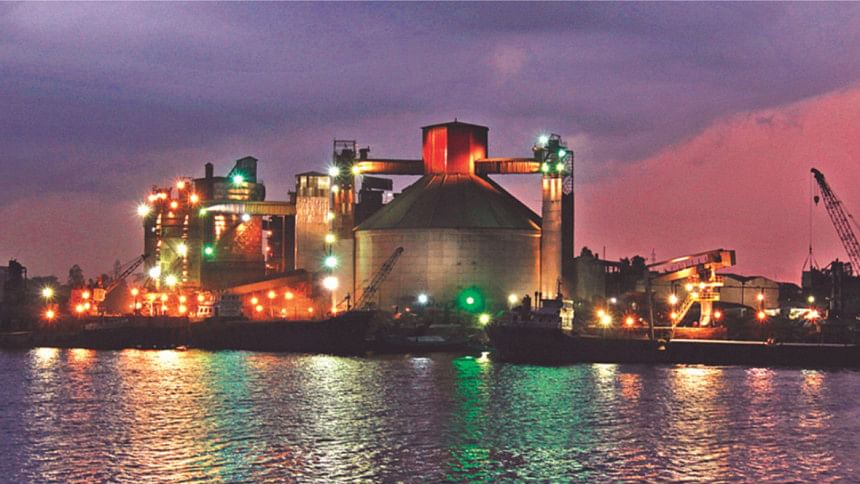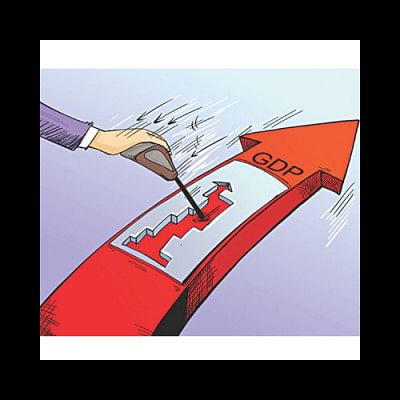Development should be the absolute principal for steady GDP Growth

It is admittedly a positive side that the development trend in Bangladesh is attributed to the upward growth trend of Gross Domestic Product (GDP) and the big challenge is to keep this trend steady.
Currently, large scale of domestic infrastructure developments are playing an important role to increase the GDP rate and it is high time we emphasized on the improvement of the sector, because a country's development is depended mostly in domestic physical infrastructural development. It does not mean only the development of the Road, Bridge, and Culvert but also comprise of infrastructural developments.
Likewise, agriculture is another sector which is the important for development of the country as it contributes a great extent in increasing GDP rate. The maximum utilization of land and fostering of agriculture is needed to meet the demand of densely populated Bangladesh. But unplanned housing and infrastructural development cannot bring about sustainable development of a country. .

Being one of the densely populated countries of the world with limited land area, we need vertical construction to make multi-storied buildings, skyscrapers to accommodate this huge population. Indeed we need high storied buildings for common people with comparatively low cost, needing small piece of land. Our horizontal land is very valuable for food production and no alternative device has yet been formulated in the world for food security without agriculture. Therefore, agricultural land should not be used for inhabitation other than ensuring food security.
Singapore and Hong Kong are exemplary small countries where large number of people with various modern amenities are accommodated on a small piece of land. The area of South Korea is almost equal to Bangladesh but they have achieved surprising development. Moreover, Taiwan, Malaysia, Qatar, UAE, Brunei, SriLanka, and some other small countries in Europe & South America have already shown widespread infrastructural development with multipurpose sustainable plan. Bangladesh has lots of scope to stand in the row of these countries of highly developed physical infrastructure.
The materials which aided the aforesaid development with cement and steel being two of the most prominent. The per-capita consumption of cement in Bangladesh is only 105 kg against which the neighboring countries like India (217 kg), Malaysia (570 kg), South Korea (705 kg), China (1700 kg) likewise in steel sector Bangladesh is only 45 kg against the neighboring countries like India (126 kg), Malaysia (374 kg), South Korea (537 kg), China (410 kg) are utilizing much more of these construction agents. Bangladesh is yet to undertake much physical infrastructural development efforts. Cement is the symbol of infrastructural development. The growth of Gross Domestic product will be increased, if the consumption of cement and steel increase.

Bangladesh is a country of heavy monsoon rain, high volume of sulphur presence in our soil, salty air, fluctuation of temperature, flood takes place almost every year and different area of land contains different strength. Based on these indications the experts make design for roads &highways. In Bangladesh roads and highways are made of asphalt base which is not suitable considering the nature of Bangladesh. It has short durability incurring huge cost. Asphalt base roads are effective in such part of the world where humidity is extremely low, does not get inundated with floods, experience rain in low frequency and temperature variations are moderate.
The six seasoned country like Bangladesh has recently built concrete road in some areas, with construction cost being 20-25% high rather than traditional asphalt road. But the longevity of concrete road is much more than the better. So, concrete road is economical and durable. Thus concrete roads are durable, economically viable and cost saving. Some countries like Southeastern area of China, Vietnam, Indonesia, Malaysia, Nigeria and Neighboring India have taken comprehensive implementation plan for making concrete road. So far they have implemented the same in wide range of area and the result is very positive. So, it is practicable to adopt this method in our roads and highways.
Till the last of the nineteenth century Bangladesh was fully dependent on imported cement. Some enthusiastic entrepreneurs ventured into setting up cement plants during 1997 to 2000 which opened a new era in this sector. Gradually , observing the potentiality of this sector, one after another cement factory began to set up, some existing one are also resorted to expanding with additional capacities and situation had soon reached such a stage that capacity exceeded demand leading to acute unhealthy competition. The manufacturers then began to seek market in overseas countries, which also proved bleak excepting exporting to neighboring country in a limited scale. The same scenario has prevailed in steel bar manufacturing industry also.
Directly or indirectly more than two million people in Bangladesh are involved with cement and steel sectors. As a result the negative impact fell in our economy and the growth of GDP rate. In addition, around sixty four thousand crore taka have been invested in cement & steel sectors, the largest part of the fund have been procured as loan from different Banks. (Report BB)
Our country is developing and we acknowledge the credit with thanks to the Government and people of Bangladesh. Besides, we expect that in continuing the flow of development, Government should come extend additional facilities to cement & steel sectors. This way we can boost production and find more new markets abroad.
.................................................................................................
The writer is the Vice President, Bangladesh Cement Manufacturer's Association (BCMA) And Chairman of GPH Ispat Ltd. – Mohammed Alamgir Kabir

 For all latest news, follow The Daily Star's Google News channel.
For all latest news, follow The Daily Star's Google News channel. 



Comments